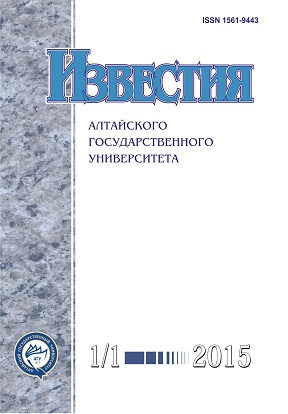Spectral Contribution of Lake Water Components to Light Attenuation Coefficient in Diverse Water Bodies of the South of Western Siberia
Abstract
The paper considers the influence of lake water components, including clean water, chlorophyll, yellow substance, organo-mineral suspension, on spectral light attenuation at wavelength of 430, 550 and 670 nm in a surface layer of three water bodies in the south of Western Siberia, namely Lakes Lapa, Krasilovskoye and Bol’shoye Ostrovnoye (Altai Krai) in different seasons of 2014. The wavelengths of 430 and 670 nm are well-known by their maximum chlorophyll absorption in the spectral range, and the wavelength of 550 nm corresponds to the high spectral transparency area of the lake water studied in the paper. In each water body, the major maximum contribution to light attenuation (ε, m-1) is provided by a suspension. The largest contribution of a suspension to the total attenuation at λ = 430 nm (in winter) is estimated in Lake Krasilovskoye (more than 70 %) and Lake Bol’shoye Ostrovnoye (79 % in spring). Yellow substance provides the maximum contribution to ε (winter) in Lakes Lapa and Bol’shoye Ostrovnoye; it is 36.5 and 35.3 % respectively. In spring, the contribution of yellow substance (Lake Lapa) increases up to 59 % at λ = 430 nm. Clean water provides a minor contribution to the light attenuation (at λ = 430 nm) in all water bodies and does not exceed 0.1 %; however, it increases sharply in the longwavelength range (16 % in Lake Lapa, and 11.5 % in Lake Krasilovskoye at λ = 670 nm). The highest possible chlorophyll contribution to ε is in winter in Lake Bol’shoye Ostrovnoye (10.2 %) only; it is much higher than in Lake Lapa (0.9 %). In spring and summer, it makes up to 17.4 and up to 35.1 % respectively, for Lake Krasilovskoye at λ = 430 nm. Molecular scattering of light by clean water in the spectral range under study does not make a significant contribution and is less than 0.1 %. The study of the surface layer optical properties of three lakes demonstrates that the highest attenuation of light was observed in Lake Bol’shoye Ostrovnoye as compared to the other two lakes. This is due, mainly, to a high content of suspended matter and yellow substance as well as fluctuations in water temperature and, as a consequence, the change in chlorophyll concentration in lake phytoplankton.
DOI 10.14258/izvasu(2015)1.1-10
Downloads
Metrics
References
Ерлов Н. Г. Оптика моря. - Л., 1980.
Оптика океана. Физическая оптика океана / под ред. А. С. Монина. - М., 1983. - Т. 1.
Шифрин К. С. Введение в оптику океана. - Л., 1983.
Маньковский В. И. Основы оптики океана : метод. пособие. - Севастополь, 1996.
Маньковский В. И. Спектральный вклад компонентов морской воды в показатель ослабления направленного света в поверхностных водах Средиземного моря // Морской гидрофизический журнал. - 2011. - № 5.
Апонасенко А. Д. Количественные закономерности функциональной организации водных экосистем в связи с их дисперсной структурой : дис.. д-ра физ.-мат. наук. - Красноярск, 2001.
Маньковский В.И., Шерстянкин П. П. Спектральная модель показателя ослабления направленного света в водах озера Байкал в летний период // Морской гидрофизический журнал. - 2007. - № 6.
Pope R.M., Fry E. S. Absorption Spectrum (380700 nm) of Pure Water. II Integration Cavity Measurements // Appl. Optics. - 1997. - V. 36, № 33.
Izvestiya of Altai State University is a golden publisher, as we allow self-archiving, but most importantly we are fully transparent about your rights.
Authors may present and discuss their findings ahead of publication: at biological or scientific conferences, on preprint servers, in public databases, and in blogs, wikis, tweets, and other informal communication channels.
Izvestiya of Altai State University allows authors to deposit manuscripts (currently under review or those for intended submission to Izvestiya of Altai State University) in non-commercial, pre-print servers such as ArXiv.
Authors who publish with this journal agree to the following terms:
- Authors retain copyright and grant the journal right of first publication with the work simultaneously licensed under a Creative Commons Attribution License (CC BY 4.0) that allows others to share the work with an acknowledgement of the work's authorship and initial publication in this journal.
- Authors are able to enter into separate, additional contractual arrangements for the non-exclusive distribution of the journal's published version of the work (e.g., post it to an institutional repository or publish it in a book), with an acknowledgement of its initial publication in this journal.
- Authors are permitted and encouraged to post their work online (e.g., in institutional repositories or on their website) prior to and during the submission process, as it can lead to productive exchanges, as well as earlier and greater citation of published work (See The Effect of Open Access).








